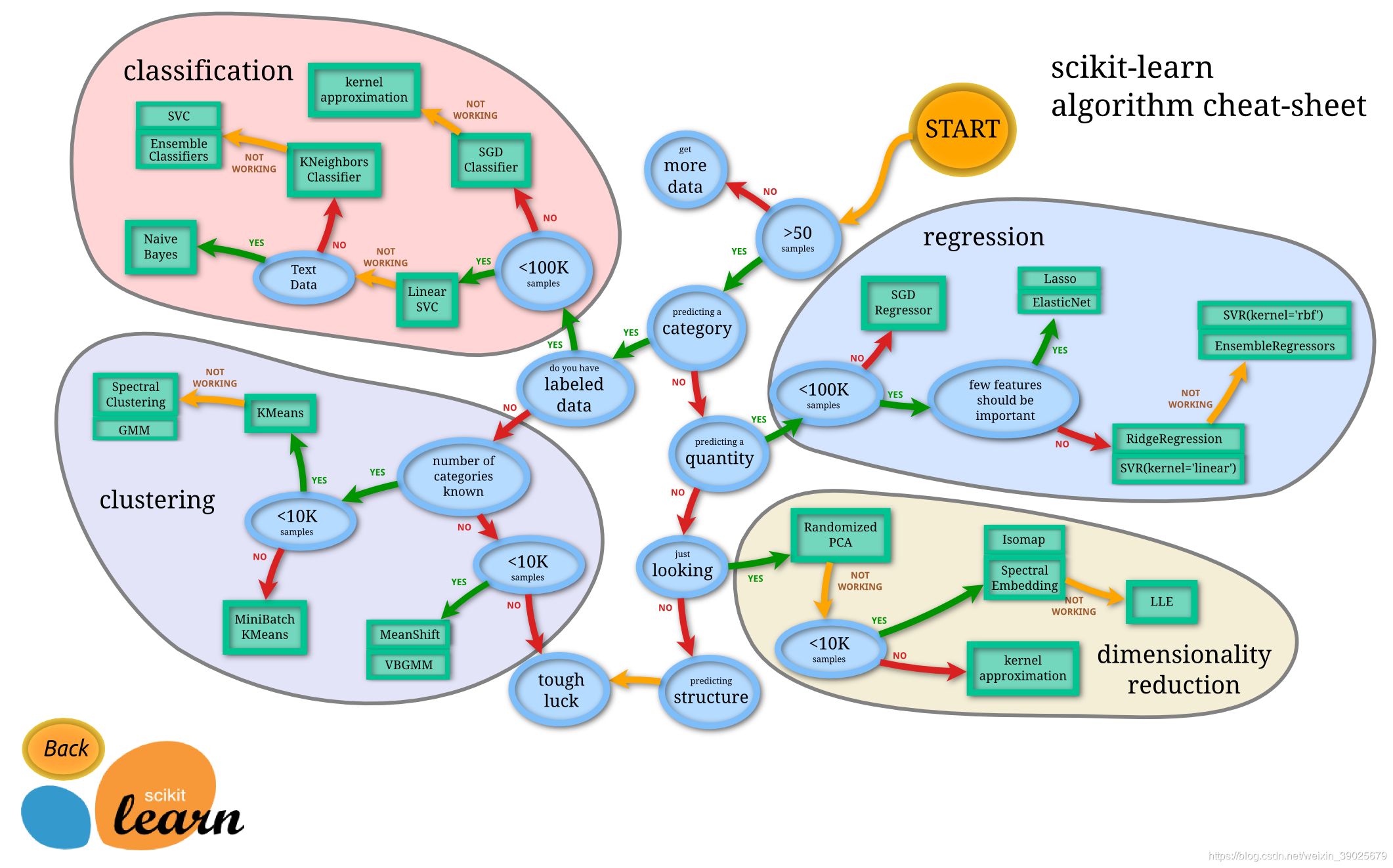sklearn framework

Mapping function

1.11. Ensemble methods
1.11.1. Bagging meta-estimator
from sklearn.ensemble import BaggingClassifier
from sklearn.neighbors import KNeighborsClassifier
bagging = BaggingClassifier(KNeighborsClassifier(),
max_samples=0.5, max_features=0.5)
1.11.2. Forests of randomized trees
from sklearn.ensemble import RandomForestClassifier
X = [[0, 0], [1, 1]]
Y = [0, 1]
clf = RandomForestClassifier(n_estimators=10)
clf = clf.fit(X, Y)
1.11.2.2. Extremely Randomized Trees
from sklearn.model_selection import cross_val_score
from sklearn.datasets import make_blobs
from sklearn.ensemble import RandomForestClassifier
from sklearn.ensemble import ExtraTreesClassifier
from sklearn.tree import DecisionTreeClassifier
X, y = make_blobs(n_samples=10000, n_features=10, centers=100,
random_state=0)
clf = DecisionTreeClassifier(max_depth=None, min_samples_split=2,
random_state=0)
scores = cross_val_score(clf, X, y, cv=5)
scores.mean()
clf = RandomForestClassifier(n_estimators=10, max_depth=None,
min_samples_split=2, random_state=0)
scores = cross_val_score(clf, X, y, cv=5)
scores.mean()
clf = ExtraTreesClassifier(n_estimators=10, max_depth=None,
min_samples_split=2, random_state=0)
scores = cross_val_score(clf, X, y, cv=5)
scores.mean() > 0.999
1.11.3. AdaBoost
1.11.3.1. Usage
from sklearn.model_selection import cross_val_score
from sklearn.datasets import load_iris
from sklearn.ensemble import AdaBoostClassifier
X, y = load_iris(return_X_y=True)
clf = AdaBoostClassifier(n_estimators=100)
scores = cross_val_score(clf, X, y, cv=5)
scores.mean()
1.11.4. Gradient Tree Boosting
1.11.4.1. Classification
from sklearn.datasets import make_hastie_10_2
from sklearn.ensemble import GradientBoostingClassifier
X, y = make_hastie_10_2(random_state=0)
X_train, X_test = X[:2000], X[2000:]
y_train, y_test = y[:2000], y[2000:]
clf = GradientBoostingClassifier(n_estimators=100, learning_rate=1.0,
max_depth=1, random_state=0).fit(X_train, y_train)
clf.score(X_test, y_test)
1.11.4.2. Regression
import numpy as np
from sklearn.metrics import mean_squared_error
from sklearn.datasets import make_friedman1
from sklearn.ensemble import GradientBoostingRegressor
X, y = make_friedman1(n_samples=1200, random_state=0, noise=1.0)
X_train, X_test = X[:200], X[200:]
y_train, y_test = y[:200], y[200:]
est = GradientBoostingRegressor(n_estimators=100, learning_rate=0.1,
max_depth=1, random_state=0, loss='ls').fit(X_train, y_train)
mean_squared_error(y_test, est.predict(X_test))
1.11.4.3. Fitting additional weak-learners
_ = est.set_params(n_estimators=200, warm_start=True) # set warm_start and new nr of trees
_ = est.fit(X_train, y_train) # fit additional 100 trees to est
mean_squared_error(y_test, est.predict(X_test))
1.11.4.7.1. Feature importance
from sklearn.datasets import make_hastie_10_2
from sklearn.ensemble import GradientBoostingClassifier
X, y = make_hastie_10_2(random_state=0)
clf = GradientBoostingClassifier(n_estimators=100, learning_rate=1.0,
max_depth=1, random_state=0).fit(X, y)
clf.feature_importances_
1.11.5. Histogram-Based Gradient Boosting
# explicitly require this experimental feature
from sklearn.experimental import enable_hist_gradient_boosting # noqa
# now you can import normally from ensemble
from sklearn.ensemble import HistGradientBoostingClassifier
1.11.5.1. Usage
from sklearn.experimental import enable_hist_gradient_boosting
from sklearn.ensemble import HistGradientBoostingClassifier
from sklearn.datasets import make_hastie_10_2
X, y = make_hastie_10_2(random_state=0)
X_train, X_test = X[:2000], X[2000:]
y_train, y_test = y[:2000], y[2000:]
clf = HistGradientBoostingClassifier(max_iter=100).fit(X_train, y_train)
clf.score(X_test, y_test)
1.11.5.2. Missing values support
from sklearn.experimental import enable_hist_gradient_boosting # noqa
from sklearn.ensemble import HistGradientBoostingClassifier
import numpy as np
X = np.array([0, 1, 2, np.nan]).reshape(-1, 1)
y = [0, 0, 1, 1]
gbdt = HistGradientBoostingClassifier(min_samples_leaf=1).fit(X, y)
gbdt.predict(X)
1.11.6. Voting Classifier
1.11.6.1.1. Usage
from sklearn import datasets
from sklearn.model_selection import cross_val_score
from sklearn.linear_model import LogisticRegression
from sklearn.naive_bayes import GaussianNB
from sklearn.ensemble import RandomForestClassifier
from sklearn.ensemble import VotingClassifier
iris = datasets.load_iris()
X, y = iris.data[:, 1:3], iris.target
clf1 = LogisticRegression(random_state=1)
clf2 = RandomForestClassifier(n_estimators=50, random_state=1)
clf3 = GaussianNB()
eclf = VotingClassifier(
estimators=[('lr', clf1), ('rf', clf2), ('gnb', clf3)],
voting='hard')
for clf, label in zip([clf1, clf2, clf3, eclf], ['Logistic Regression', 'Random Forest', 'naive Bayes', 'Ensemble']):
scores = cross_val_score(clf, X, y, scoring='accuracy', cv=5)
print("Accuracy: %0.2f (+/- %0.2f) [%s]" % (scores.mean(), scores.std(), label))
1.11.6.2. Weighted Average Probabilities (Soft Voting)
from sklearn import datasets
from sklearn.tree import DecisionTreeClassifier
from sklearn.neighbors import KNeighborsClassifier
from sklearn.svm import SVC
from itertools import product
from sklearn.ensemble import VotingClassifier
# Loading some example data
iris = datasets.load_iris()
X = iris.data[:, [0, 2]]
y = iris.target
# Training classifiers
clf1 = DecisionTreeClassifier(max_depth=4)
clf2 = KNeighborsClassifier(n_neighbors=7)
clf3 = SVC(kernel='rbf', probability=True)
eclf = VotingClassifier(estimators=[('dt', clf1), ('knn', clf2), ('svc', clf3)],
voting='soft', weights=[2, 1, 2])
clf1 = clf1.fit(X, y)
clf2 = clf2.fit(X, y)
clf3 = clf3.fit(X, y)
eclf = eclf.fit(X, y)
1.11.6.3. Using the VotingClassifier with GridSearchCV
from sklearn.model_selection import GridSearchCV
clf1 = LogisticRegression(random_state=1)
clf2 = RandomForestClassifier(random_state=1)
clf3 = GaussianNB()
eclf = VotingClassifier(
estimators=[('lr', clf1), ('rf', clf2), ('gnb', clf3)],
voting='soft'
)
params = {'lr__C': [1.0, 100.0], 'rf__n_estimators': [20, 200]}
grid = GridSearchCV(estimator=eclf, param_grid=params, cv=5)
grid = grid.fit(iris.data, iris.target)
1.11.7. Voting Regressor
from sklearn.datasets import load_boston
from sklearn.ensemble import GradientBoostingRegressor
from sklearn.ensemble import RandomForestRegressor
from sklearn.linear_model import LinearRegression
from sklearn.ensemble import VotingRegressor
# Loading some example data
X, y = load_boston(return_X_y=True)
# Training classifiers
reg1 = GradientBoostingRegressor(random_state=1, n_estimators=10)
reg2 = RandomForestRegressor(random_state=1, n_estimators=10)
reg3 = LinearRegression()
ereg = VotingRegressor(estimators=[('gb', reg1), ('rf', reg2), ('lr', reg3)])
ereg = ereg.fit(X, y)
1.11.8. Stacked generalization
from sklearn.linear_model import RidgeCV, LassoCV
from sklearn.svm import SVR
estimators = [('ridge', RidgeCV()),
('lasso', LassoCV(random_state=42)),
('svr', SVR(C=1, gamma=1e-6))]
from sklearn.ensemble import GradientBoostingRegressor
from sklearn.ensemble import StackingRegressor
reg = StackingRegressor(
estimators=estimators,
final_estimator=GradientBoostingRegressor(random_state=42))
from sklearn.datasets import load_boston
X, y = load_boston(return_X_y=True)
from sklearn.model_selection import train_test_split
X_train, X_test, y_train, y_test = train_test_split(X, y,
random_state=42)
reg.fit(X_train, y_train)
y_pred = reg.predict(X_test)
from sklearn.metrics import r2_score
print('R2 score: {:.2f}'.format(r2_score(y_test, y_pred)))
source address
https://scikit-learn.org/stable/modules/ensemble.html
